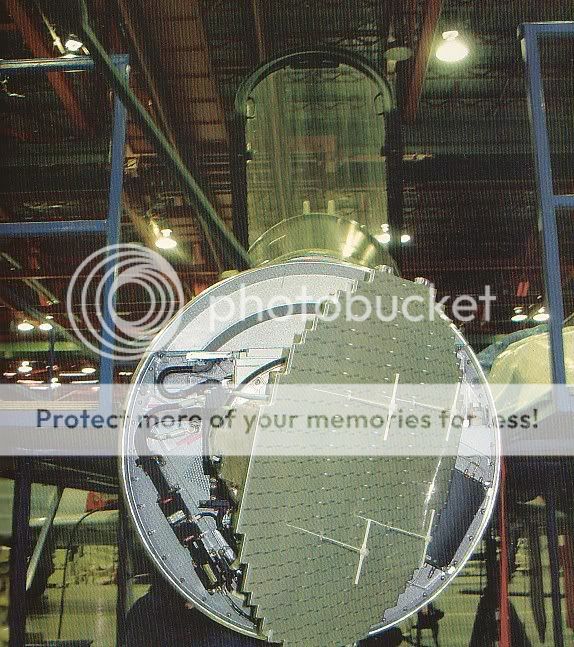Dr Saab,
Both PESA and AESA can scan without mechanically steering!
If that was the case then would it not be called Mechanically Steered Array (MSA).
All ESA radars, PESA or AESA can steer their beams electronically.
I thought that would be fairly obvious.
ya thats right i messed it up a bit

but i meant to say about hybrid radars (mechanical phased array radars)
but let us brush up once again about various radars for our convienience
Portable Airborne Radars
This is the category that we are talking about most of the time. These are portable radars mounted on fighter aircraft. They are small and less powerful when compared to land or airborne radar systems but they can be installed on small aircraft and play the most crucial role in any combat, since its the fighter aircraft which has to shoot down the opponent. These radars detect enemy aircraft and also guide the missiles to their targets.
There are different types of portable radars:
-
Mechanically Scanned Radar
- PESA (Passive Electronically Scanned Array)
- AESA (Active Electronically Scanned Array)
- Mechanical Phased Array Radars
Now I am going to explain them in detail.
Mechanically Steered Radar
These are conventional radar systems that measures the location of a target in two dimensions-range and azimuth. The elevation angle, from which target height can be derived, also can be determined. This radar measures range in a conventional manner but, but uses a second conceptual antenna to measure elevation. The elevation-measuring component has a beam that is mechanically or electronically rotated about a vertical axis to obtain the azimuth angle of a target, plus either a scanning narrow beam or multiple fixed beams to measure the elevation angle.
The antenna in mechanically steered radar is steered manually, which increases the radar's horizontal field view. They can have a field view of more than 150 degrees. But since they are steered mechanically, their failure rates are high. Also steering take some time, so refresh rates are slow. Scan rates are low and the range of the radar too is limited.
Advantages:
- Very low cost
- Very large horizontal field view
Disadvantages:
- Very slow scan rates
- Limited range
- High failure rate
- High Maintenance
Examples:
RDY-2 radar used on Mirage 2000
PESA (Passive Electronically Scanned Array)
In PESA, which represented a major advance over mechanically scanned antennas, there is a single source of radar energy, which is then shifted among large numbers (often thousands) of transmitting elements, usually that can receive as well. The elements are passive in that they do not have independent energy sources.
Phased arrays not only are faster and more maintenance-free, but can do things that radars with moving antennas cannot. Earlier radar systems contributed heavily to the Radar Cross Section of the aircraft. With PESA radars, this limitation was removed. F-117 didn't have a radar due to this reason, but with the advent of PESA, B-2 could finally have a radar for precise navigation and missile guidance.
PESA radar utilize a stationary radar antenna. Since there are no moving parts, the failure rate of radar also reduced and maintenance was also no required so frequently for these radars. Although the T/R modules increased the range of the radar, they also have major disadvantages. The horizontal field view of PESA radar is very low when compared to earlier mechanical radars. To overcome this drawback, most heavy class aircraft use more than one radar, a primary radar on the nose and several secondary radars, on wings and tail.
Advantages:
- High range
- Extremely high scan rates
- Very low maintenance
- Fault of single components reduces the capability and beam sharpness, but the system remains operational
Disadvantages:
- Very limited horizontal field view
- Deformation of the beam while the deflection
- Low frequency agility
Examples:
Irbis-E PESA Radar on the Su-35BM
This radar can also be used as a hybrid radar when steered mechanically.
AESA (Active Electronically Scanned Array)
As much as an advance over PESA as PESA was over mechanically steered antennas, every transmit/receive element in an AESA has its own source of radar energy. This allows the construction of extremely complex, low-probability-of-intercept active beams. There is no longer a single point of failure.
Different elements can be forming a complex low probability of intercept (LPI) transmitted signal, receiving signals reflected back to the AESA, or jamming hostile radars. Further, the AESA can receive either the reflections of its own transmitters, or listen for the reflections from another radar source, such as a large airborne radar aircraft. An AESA-equipped fighter can get close to engagement range with a target and its pilot sees clearly on the radar display, yet the fighter may be emitting no signals that can be tracked. The first warning received by the target is likely to be an incoming air-to-air missile.
AESA moves a generation ahead in low probability of intercept, as it can spread its signal among a pseudo-random set of transmitting antennas, creating a beam that is very hard to visualize. This is the reason jamming a AESA radar is almost impossible. The frequency of the signal keeps shifting almost instantaneously varying from one frequency to another. The only way to jam an AESA is to jam the complete spectrum which is not possible.
AESA does not have an advantage of range over PESA but since each T/R module is independent, some of the modules can be switched off when radar doesn't need to operate at full range. This allows the modules to cool down and be available when required. So more T/R modules can be installed on an AESA than on a PESA. The increased range of the AESA is because of more T/R modules and not because it is technically superior.
Advantages:
- High range
- Independent T/R modules
- Impossible to jam
- Extremely high scan rates
- Fault of single components reduces the capability and beam sharpness, but the system remains operational
Disadvantages:
- Very high initial cost
- Very limited horizontal field view.
- Deformation of the beam while the deflection
- Low frequency agility
Examples:
APG-81 radar on the F-35 Lightening-II
Mechanical Phased Array Radars
These are often termed as hybrid radars. They are AESA or PESA antennas steered mechanically. This gives the radar the best of both the worlds. The mechanical steering increases the horizontal field view of the radar to over 150 degrees and the Electronic Scanning provides excellent detection ranges. These radars do contribute to the rcs of the aircraft, which is the reason they are not used on aircraft for which Low observability is a requirement.
Advantages:
- Highest range
- Combines features of MSR and Phased Array radars(PESA or AESA)
- Highest field view
- Fastest scan rates
Disadvantages:
- Increases RCS of the aircraft
- Expensive
- Maintenance heavy
Examples:
N011M Bars ESA Radar on the Su30MKI
PLEASE NOTE ( thank u bro JAGITNATT for the information )
mate they are L-Band IFF probes... they have nothing to do with whether the radar is AESA or PESA.
Similarly I can show you PESA or other radars with IFF probes located elsewhere...
Here an F-16 with the AN/APG-68v9... no IFR probes there...
Take the F-16...
instead they are located here...
well mate u can find it or u may not find it in PESA & that's true ,but i havent seen any AESA radar in this world which has IFF probes in it .So it raises the suspicion about j10b radar to be aesa.


















 yes IRST thing i can consider
yes IRST thing i can consider ,atleast post an chinese article about j10b aesa radar so that atleast i could translate it
,atleast post an chinese article about j10b aesa radar so that atleast i could translate it 

 but read post#99 u might get some
but read post#99 u might get some

